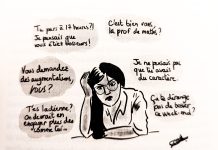«Ethno-mathématicien” Ron Eglash est l’auteur de fractales africains, un livre qui examine les motifs fractals qui sous-tendent l’architecture, l’art et le design dans de nombreuses régions d’Afrique.
En regardant la carte aérienne de photos – puis en faisant des recherches approfondies sur le terrain – Eglash découvert que de nombreux villages africains sont volontairement aménagés pour former fractales parfaites, avec des formes auto-similaires répétées dans les pièces de la maison, et les grappes de maisons dans le village, suivant des modèles mathématiquement prévisibles.
Comme il le dit: «Quand les Européens sont arrivés en Afrique, ils ont considéré l’architecture très désorganisé et donc primitive Il n’est jamais venu à l’esprit que les Africains auraient pu utiliser une théorie mathématiques qu’ils n’avaient même pas encore découvert.».
Ses autres domaines d’étude sont tout aussi fascinants, y compris la recherche en Afrique et la cybernétique des autochtones d’Amérique, l’enseignement des mathématiques aux enfants par des outils de conception culturellement spécifiques (telles que l’applet Virtual Breakdancer, qui explore les fonctions de rotation et sinus), la race et l’appartenance ethnique dans les questions scientifiques et technologie. Eglash enseigne au Département des sciences et études technologiques au Rensselaer Polytechnic Institute à New York, et il a récemment co-édité le livre “L’appropriation de la technologie, de la façon dont nous réinventer technologie des consommateurs pour nos propres besoins”.
La prochaine fois que vous rencontrez un de ces idiots qui vous interpellent vous posant des questions comme: « Où est le Mozart africain, ou où est le Brunel africain ? – Ce qui implique que les Africains ne pensent pas – envoyez-leur une copie de l’étude Ron Eglash de fractales dans l’architecture africaine et regardez leurs têtes explosées. mentalacrobatics.com
“Ethno-mathematician” Ron Eglash is the author of African Fractals, a book that examines the fractal patterns underpinning architecture, art and design in many parts of Africa.
By looking at aerial-view photos — and then following up with detailed research on the ground — Eglash discovered that many African villages are purposely laid out to form perfect fractals, with self-similar shapes repeated in the rooms of the house, and the house itself, and the clusters of houses in the village, in mathematically predictable patterns.
As he puts it: “When Europeans first came to Africa, they considered the architecture very disorganized and thus primitive. It never occurred to them that the Africans might have been using a form of mathematics that they hadn’t even discovered yet.”
His other areas of study are equally fascinating, including research into African and Native American cybernetics, teaching kids math through culturally specific design tools (such as theVirtual Breakdancer applet, which explores rotation and sine functions), and race and ethnicity issues in science and technology. Eglash teaches in the Department of Science and Technology Studies at Rensselaer Polytechnic Institute in New York, and he recently co-edited the book Appropriating Technology, about how we reinvent consumer tech for our own uses.
Next time you bump into one of those idiots who starts asking you questions like, ‘where is the African Mozart, or where is the African Brunel?’ — implying that Africans do not think — send them a copy of Ron Eglash’s study of fractals in African architecture and watch their heads explode. mentalacrobatics.com
Source : TED




